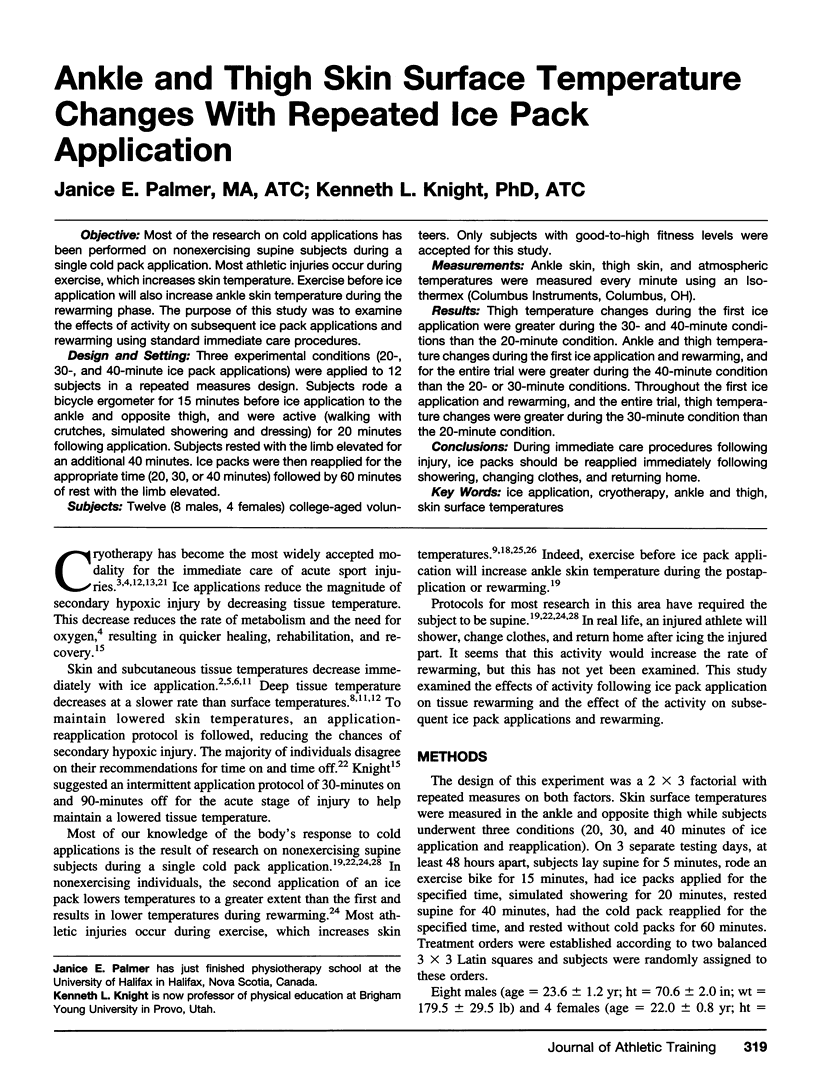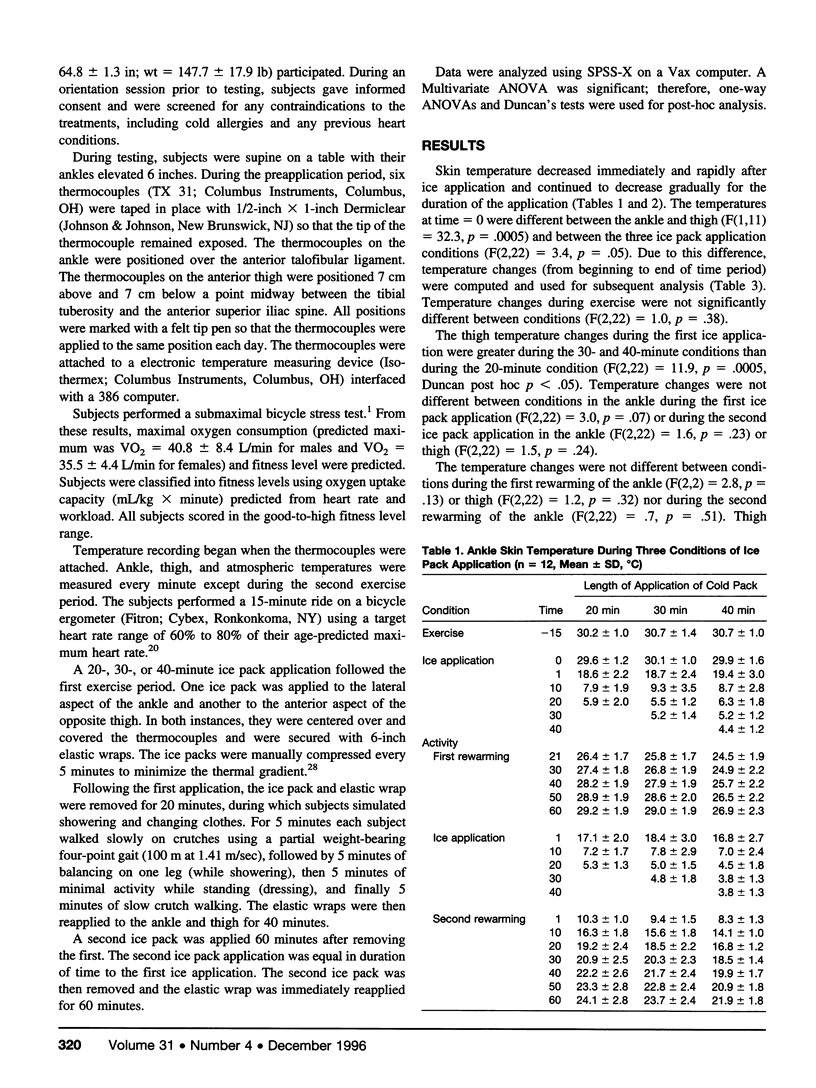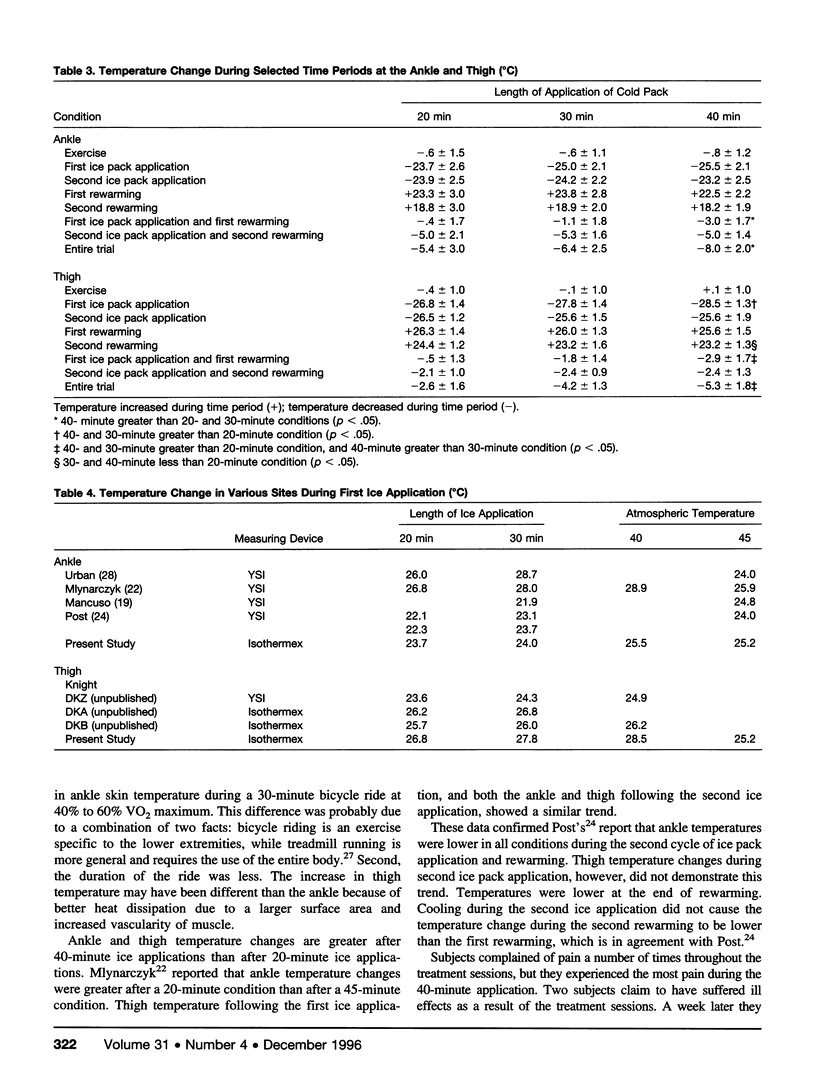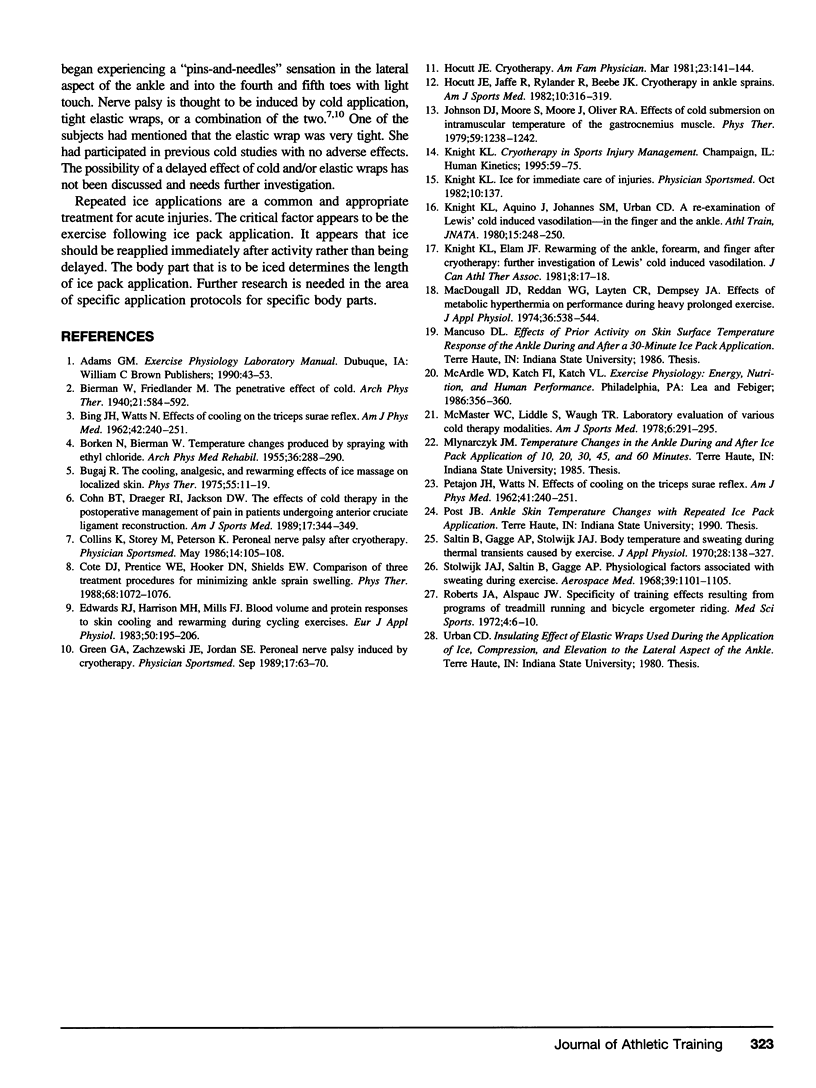Abstract
Objective:
Most of the research on cold applications has been performed on nonexercising supine subjects during a single cold pack application. Most athletic injuries occur during exercise, which increases skin temperature. Exercise before ice application will also increase ankle skin temperature during the rewarming phase. The purpose of this study was to examine the effects of activity on subsequent ice pack applications and rewarming using standard immediate care procedures.
Design and Setting:
Three experimental conditions (20-, 30-, and 40-minute ice pack applications) were applied to 12 subjects in a repeated measures design. Subjects rode a bicycle ergometer for 15 minutes before ice application to the ankle and opposite thigh, and were active (walking with crutches, simulated showering and dressing) for 20 minutes following application. Subjects rested with the limb elevated for an additional 40 minutes. Ice packs were then reapplied for the appropriate time (20, 30, or 40 minutes) followed by 60 minutes of rest with the limb elevated.
Subjects:
Twelve (8 males, 4 females) college-aged volunteers. Only subjects with good-to-high fitness levels were accepted for this study.
Measurements:
Ankle skin, thigh skin, and atmospheric temperatures were measured every minute using an Isothermex (Columbus Instruments, Columbus, OH).
Results:
Thigh temperature changes during the first ice application were greater during the 30- and 40-minute conditions than the 20-minute condition. Ankle and thigh temperature changes during the first ice application and rewarming, and for the entire trial were greater during the 40-minute condition than the 20-or 30-minute conditions. Throughout the first ice application and rewarming, and the entire trial, thigh temperature changes were greater during the 30-minute condition than the 20-minute condition.
Conclusions:
During immediate care procedures following injury, ice packs should be reapplied immediately following showering, changing clothes, and returning home.
Keywords: ice application, cryotherapy, ankle and thigh, skin surface temperatures
Full text
PDF




Selected References
These references are in PubMed. This may not be the complete list of references from this article.
- BORKEN N., BIERMAN W. Temperature changes produced by spraying with ethyl chloride. Arch Phys Med Rehabil. 1955 May;36(5):288–290. [PubMed] [Google Scholar]
- Bugaj R. The cooling, analgesic, and rewarming effects of ice massage on localized skin. Phys Ther. 1975 Jan;55(1):11–19. doi: 10.1093/ptj/55.1.11. [DOI] [PubMed] [Google Scholar]
- Cohn B. T., Draeger R. I., Jackson D. W. The effects of cold therapy in the postoperative management of pain in patients undergoing anterior cruciate ligament reconstruction. Am J Sports Med. 1989 May-Jun;17(3):344–349. doi: 10.1177/036354658901700306. [DOI] [PubMed] [Google Scholar]
- Coté D. J., Prentice W. E., Jr, Hooker D. N., Shields E. W. Comparison of three treatment procedures for minimizing ankle sprain swelling. Phys Ther. 1988 Jul;68(7):1072–1076. doi: 10.1093/ptj/68.7.1072. [DOI] [PubMed] [Google Scholar]
- Edwards R. J., Harrison M. H., Cochrane L. A., Mills F. J. Blood volume and protein responses to skin cooling and warming during cycling exercise. Eur J Appl Physiol Occup Physiol. 1983;50(2):195–206. doi: 10.1007/BF00422158. [DOI] [PubMed] [Google Scholar]
- Hocutt J. E., Jr Cryotherapy. Am Fam Physician. 1981 Mar;23(3):141–144. [PubMed] [Google Scholar]
- Hocutt J. E., Jr, Jaffe R., Rylander C. R., Beebe J. K. Cryotherapy in ankle sprains. Am J Sports Med. 1982 Sep-Oct;10(5):316–319. doi: 10.1177/036354658201000512. [DOI] [PubMed] [Google Scholar]
- Johnson D. J., Moore S., Moore J., Oliver R. A. Effect of cold submersion on intramuscular temperature of the gastrocnemius muscle. Phys Ther. 1979 Oct;59(10):1238–1242. doi: 10.1093/ptj/59.10.1238. [DOI] [PubMed] [Google Scholar]
- MacDougall J. D., Reddan W. G., Layton C. R., Dempsey J. A. Effects of metabolic hyperthermia on performance during heavy prolonged exercise. J Appl Physiol. 1974 May;36(5):538–544. doi: 10.1152/jappl.1974.36.5.538. [DOI] [PubMed] [Google Scholar]
- McMaster W. C., Liddle S., Waugh T. R. Laboratory evaluation of various cold therapy modalities. Am J Sports Med. 1978 Sep-Oct;6(5):291–294. doi: 10.1177/036354657800600513. [DOI] [PubMed] [Google Scholar]
- PETAJAN J. H., WATTS N. Effects of cooling on the triceps surae reflex. Am J Phys Med. 1962 Dec;41:240–251. [PubMed] [Google Scholar]
- PETAJAN J. H., WATTS N. Effects of cooling on the triceps surae reflex. Am J Phys Med. 1962 Dec;41:240–251. [PubMed] [Google Scholar]
- Roberts J. A., Alspaugh J. W. Specificity of training effects resulting from programs of treadmill running and bicycle ergometer riding. Med Sci Sports. 1972 Spring;4(1):6–10. [PubMed] [Google Scholar]
- Saltin B., Gagge A. P., Stolwijk J. A. Body temperatures and sweating during thermal transients caused by exercise. J Appl Physiol. 1970 Mar;28(3):318–327. doi: 10.1152/jappl.1970.28.3.318. [DOI] [PubMed] [Google Scholar]
- Stolwijk J. A., Saltin B., Gagge A. P. Physiological factors associated with sweating during exercise. Aerosp Med. 1968 Oct;39(10):1101–1105. [PubMed] [Google Scholar]


